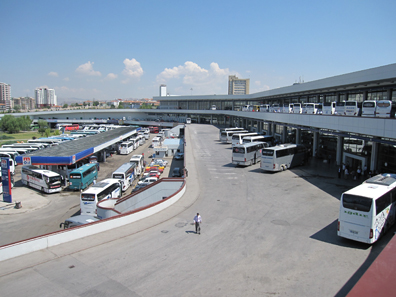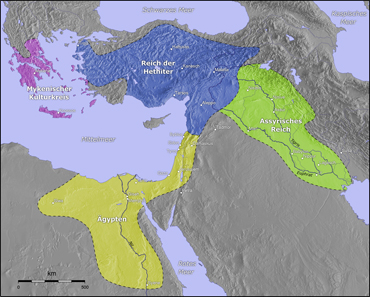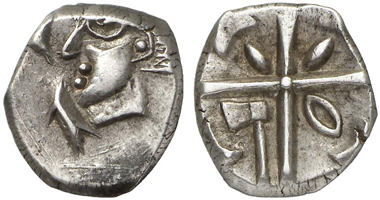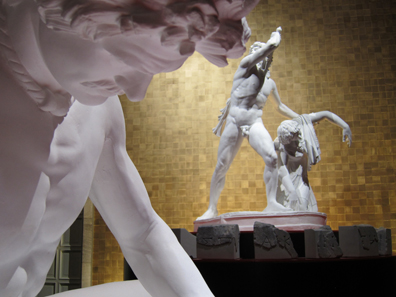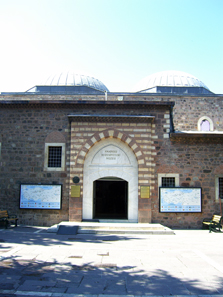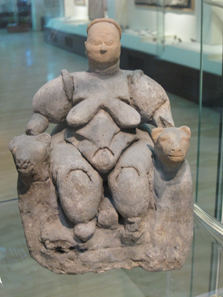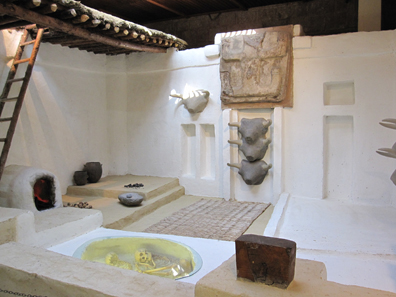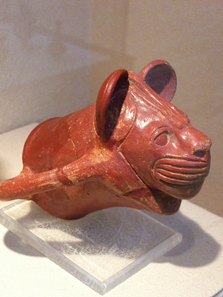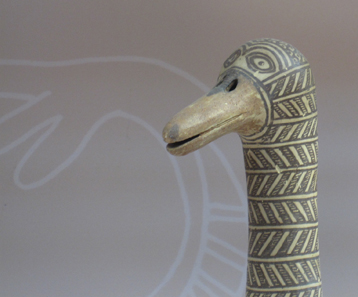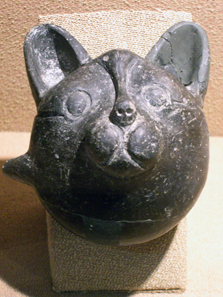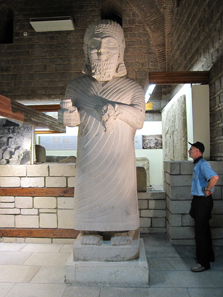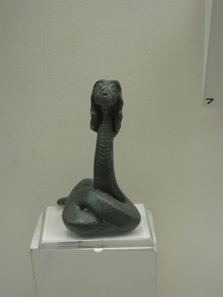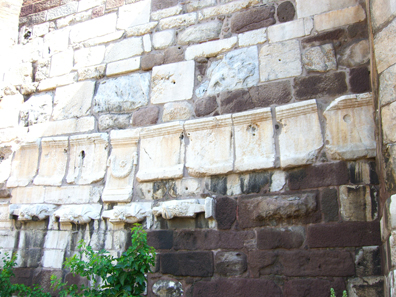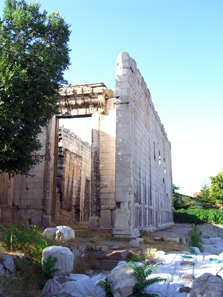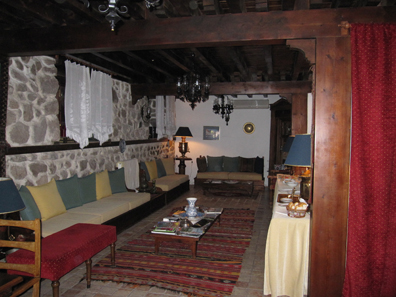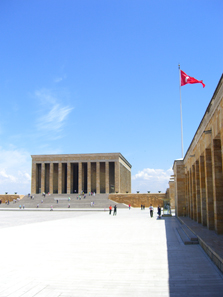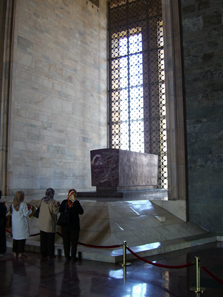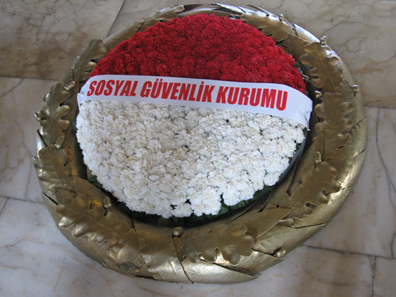March 22 2012 – Ankyra is a name familiar to anyone interested in the history of the Roman emperors. The Monumentum Ancyranum is a magnificent insight into the image cultivation of Emperor Augustus. Turkish Ankara, however, has much more to offer.
June 28, 2009
We left Caesarea Cappadocia to go to Ankara. At the bus stop we needn’t wait for too long. I guess every second bus is heading for Ankara anyway. It was, however, cramped with men, presumably all commuters going into town again after spending the weekend at home.
Bus terminal of Ankara, bigger than many airports. Photograph: KW.
Having arrived in Ankara we were faced with utter chaos. The local bus terminal puts every airport of any old metropolis in the shade. Busses heading for any number of places in Turkey depart from several hundred gates on three different floors. Every passenger is accompanied by his whole family to the effect that hundreds of thousands of people bustle about the grounds. And we and our suitcases were right in the middle of things. It was hot, we were tired, it was confusing, the man at the information desk of course only spoke Turkish, but miraculously we found the metro connecting the city center of Ankara with the bus terminal.
Map of the Hittite Empire. Source: Wikipedia / http://gmt.soest.hawaii.edu.
Ankara is located in the middle of the area the Turkish propaganda wants to identify as the country’s center, i.e. where the Hittites had established their great empire. Ankara is said to have been populated as early as the Hittite Period. Under the Phrygians, a small mountain village developed here that was already called Ankara. The Lydians came later and the Persians. Ankara became a station on the Persian Royal Road between Susa and Sardeis.
Drachm, probably of the Volcae Tectosages from the 1st cent. B. C. From auction Künker 204 (2012), 50.
Ankara gained historical significance thanks to the Celtic tribe of the Tectosages. Until the 4th cent. B. C. at the latest more and more warriors went south, and these warriors were unsteady and always looking for booty. They hired as mercenary soldiers, but teamed up as well to go buccaneering on their own when the local central power had other things on its mind. Greece was a particularly easy prey in the turmoil after the death of Alexander. And the diadochs knew well that the battle-tested men were able to help them to enforce their power.
The statues of the dying Gauls from Pergamon are reminiscent of the Celtic settlers in Galatia. Plaster cast exhibition Berlin 2011. Photograph: UK.
Nicomedes I brought these mercenary soldiers to Asia Minor. The bigger part of them is said to have belonged to the tribe of the Tectosages. They were resettled near Ankara and gave the region the name Galatia.
Even though the Pergamene rulers had themselves praised as great victors over the Gauls, the region was ultimately pacified only under the Romans. Augustus founded a colony with Ankara as center in 25 B. C. Already a couple of decades later, a Christian congregation must have existed there. After all, Paul wrote his famous letter to the Galatians.
After Byzantines, Arabs, Seljuqs, Mongolians and Turks had battled for the city, Ankara became just an Ottoman provincial town with goat wool as the only product of importance. In contrast to Roman times, when Ankara is said to have been inhabited by roughly 200,000 citizens, in the early 20th century only c. 30,000 people had lived there.
Portraits of Atatürk are everywhere. This is an example from Antalya. Photograph: UK.
After Greek troops had seized Western Anatolia in 1920, the Turkish chose remote Ankara as location for their provisional national government. This provisional solution became a permanency. On October 13, 1923, the official ceremony followed. Although hurly-burly Istanbul is much bigger and more densely populated, a real understanding of Turkey only comes with a visit of its capital. By the way, some buildings bear a disturbing resemblance to German buildings from National Socialism. A reason for that might be that Atatürk had consulted German city planners and architects of the 1930s for the planning of the city.
Entrance to the Museum of Anatolian Civilizations. Photograph: KW.
June 29, 2009
We were amongst the first visitors entering the Museum of Anatolian Civilizations, early in the morning, at half past eight. That was a good decision that kept us from cutting our way through the crowds. The exhibits were truly excellent! The museum houses the cream of the crop from the entire country. The combination of different idols is overwhelming in itself. The skilful presentation of many objects in addition brought the museum the annual ICOM award of 1997 (which, however, seems a bit over the top when considering other museums).
Idol. Photograph: KW.
At the beginning, you can see the wall paintings from the Paleolithic Age that had been removed from different caves near Ankara and, most of all, near Antalya. Next are the findings from Catal Hüyük, probably the most ancient city of the world. Especially impressive is the steatopygous idol with the swelling layers of fat that is shown in every book on the Neolithic Age.
Reconstruction of a house of Catal Hüyük. Photograph: KW.
Likewise nice was a reconstruction of the interior of a house of Catal Hüyük, albeit it was there already 20 years ago. The findings from proto-Hittite, Assyrian and Hittite Times followed – of the Assyrian Times naturally the findings from the trade colonies only because the Turks don’t count the Assyrians amongst their ancestors.
Ceramic vessel in the shape of a lioness’ head. Photograph: UK.
True highlights everywhere, be it the ceramic vessels in the shape of animals (yes, the artists had really seen lions with their own eyes…)
Vessel in the shape of a duck. Photograph: KW.
… the ducks looks as if they were about to say “quack” the next second…
Vessel in the shape of a cat. Photograph: KW.
…a small kitten was so sweet that you would have liked to pet her; be it the jewellery, the moulds for bronze tools, the tablets with cuneiform script. The best of the best, you would have wanted to burst into a storm of enthusiasm in front of every single object.
Furniture remains from the so-called Midas’ Tomb. Photograph: KW.
It was the same with the fabulous grave ensemble of The Great Tumulus of Gordium which the Turks ascribe to the Phrygians and which they identify as burial of old King Midas. Although I am not inclined to believe them (I am a heretic, as I don’t see Philip II buried in the famous royal tombs at Vergina, too), the decoration was lavish. The wooden furniture of finest workmanship, in particular, testifies to the artists’ skill. The burial most probably dates to Archaic Times, at least the figural representations remind me very much of Greek Archaic Times. The last room was devoted to Urartu which is a bit remote, geographically and chronologically.
Monumental statue from Carchemish. Photograph: KW.
In the main room of the museum the reliefs from Carchemish were on display. Today, the excavation site is located on the frontier between Turkey and Syria and completely mined so that a visit can’t be recommended. The reliefs had been transported to Ankara; they are a magnificent testimony to the afterlife of the Hittite culture.
Right in the middle of this room we were once again faced with the controversy of Cultural Property (I can’t stand it anymore). In 1998, a package with coins had been stopped in Zurich, at Kloten Airport, whose place of origin might be Turkey – a file was suited, and the coins “of inestimable value” were returned. Now, they lied in the showcase, towering on various small heaps, with the “inestimable value” of the roughly 3,000-4,000 objects adding up to less than 20,000 Euros, at a rough guess. The least object in the neighboring rooms was worth many times of what was called “saved Turkish national heritage” here. The funny thing was, there were mainly tetradrachms of the Armenian king Tigranes II there, which the Turks surely don’t address as their ancestor, a lot of Seleucids, a number of coins from Roman provinces, two or three Byzantine pieces, and perhaps four Ottoman dirhems. All perfect national heritage, of course.
Statue of the god Glycon – if you like to read his funny story please click here. Photograph: KW.
In the meantime, the museum had filled with groups of tourists. Interesting how many Japanese plagued the Museum of Anatolian Civilizations this day. I sincerely hope that I never make such a spectacle of myself in the face of other cultures. Especially a group of middle-aged ladies behaved as if they had just come of age. In the Roman room with a naked Dionysus they freaked out – like they had never seen a naked man before in their lives. Kurt got more and more nervous, annoyed and said at some point: “One likes to yell for silence.” I turned around unexcitedly and yelled “Quiet!“ The impact was huge. There actually was silence, the noise level rose only slowly again, but didn’t reach the previous level anymore.
View at the Byzantine fortified wall of the old town. Photograph: KW.
We spent the entire morning at the museum and had lunch high above the city on the castle in a restaurant with the curious name ‘Washington’. The view was magnificent. We looked at the fortified walls that contained the funniest spolia. My clever book says that parts of the wall might date back to the Galatians, but, at any rate, the Byzantines had continued building to a large extent and, to facilitate their work, used everything they could find on the Roman roads.
The Temple of Augustus. Photograph: UK.
In the afternoon, we went for the Temple of Augustus, where one of the most famous Roman inscriptions had been written down, the Monumentum Ancyranum.
It wasn’t easy to find the temple in the mass of bazaar, dolmushs, stores, people, cars, shouting and gecekondular. Gecekondu means “built overnight”, and these shacks, mostly built from plywood and corrugated sheet, refer to an Islamic law which forbids to expel people from their home which they had built overnight. In Ankara, Istanbul and a lot of other Turkish cities, many people live in such slums of which quite a number really blossom out. After all, a lot of families with many children stay there, who are interesting potential voters. From time to time, after a number of years, the old gecekondular are legalized, given a water supply, a mosque is being built (perhaps even a school) and Ankara got itself a new quarter.
You can look at the famous inscription from afar. Photograph: KW.
From my visit 20 years ago I remembered the Temple of Augustus being located next to sanctuary of Haji Beyram. That was right, and we found the sanctuary. Lying inconspicuously in the shade of the mosque, completely surrounded by iron fences, firmly locked and inaccessible, there was the Temple of Augustus with it famous inscription. The temple had been rebuilt into a church in Byzantine Times which had preserved the major part of the recounts of Augustus that was written in two languages, Latin and Greek. Thanks to other fragments of this inscription that had been discovered in other temples of Augustus throughout the entire empire, it was possible to reconstruct it almost completely. It is one of the most important personal testimonials of a Roman emperor.
We crept around the temple to gain entry somewhere. No chance. Here in Ankara the Romans are not too important (they are given the museum’ basement not by chance). No Turk can understand why the tourists are interested in the old temple! Of course we wanted to know how we could enter. A guard replied, ‘no problem’ and went to ask at the police station. He returned to tell us with pride that it was an old church, very old, 200 years at least. We informed him that we already knew that and wanted to know how we could get in! He had no idea, and there would be no getting in.
Column of Julian the Apostate. Photograph: UK.
We surrendered and decided to look for the Column of Julian the Apostate. It became something of a problem. Deep in my mind I had the connection ‘column – lots of cars’. And indeed, there was any number of dolmushs underneath the sanctuary of Haji Beyram which a giant stairway connected with the bus terminal. So we walked around the bus terminal, looked here and there, went a few streets further and were about to quit when all of a sudden we faced the column. As a matter of fact, it was situated only a few meters away from the bus terminal in a new installation. Back then, it may have been situated right in the middle of the bus terminal which was why in my mind I had connected the column with cars.
Our hotel in Ankara. Photograph: KW.
June 30, 2009
Today I woke up, being in a good mood. It simply is nice to stay in a pleasant environment. Our hotel is tastily decorated in Turkish style. There is no need of an air conditioner. The walls are thick, the ceilings high, and the temperature is delightful. The breakfast, too, was pleasing. The range of offer was tiny, but everything on offer was of finest quality and presented in a delicious way. Every guest was served its own basket with bread that was freshly sliced. They had marvelous green and black olives, goat cheese, ordinary cheese, sausage (I might even try it sometimes), two kinds of jam and, of course, Turkish tea. Classical music was played, discreetly in the background, the patio was breezy and we would have liked to sit there for much longer and chatted, we really enjoyed it.
Mausoleum of Atatürk. Photograph: UK.
The destination of our trip today was the Mausoleum of Atatürk. I had already seen it and Kurt wasn’t that interested but Ankara doesn’t offer so many other sights. So we walked across the city to arrive at Atatürk roughly one hour later. It is a huge, depressing building with a beautifully maintained garden around it. An Atatürk museum has been erected as well by now, plus a War of Independence Museum, a small cinema, two cafés as of late and a big souvenir shop.
Prayerful people in front of Atatürk’s memorial. Photograph: KW.
I vividly remember the local personality cult causing me problems already 20 years ago. Admittedly, I admire Atatürk as a reformer, but I have issues with the deification practised around here. The Turkish army, which plays an important role in society and politics, clearly has an interest in the cultivation of the Atatürk cult. After all, the generals regard themselves keeper of his legacy which they have to safeguard mainly from Islamists, Kurds and Non-Turkish people. Atatürk and his accomplishments are their legitimization. And good old “gaffer” (this title goes back to Kurt) probably wouldn’t fight it at all. His intention was to modernize and westernize Turkey with all means necessary, and for that he unscrupulously exploited his fame as war hero, to carry out reforms against any resistance.
Laurel crown in front of the sarcophagus of Atatürk. Photograph: KW.
First stop for every visitor is the cinema where a movie about Atatürk can be seen – it is simply gruesome how often the smart, blue eyes of the adorable genius are used to look at the youth in whose hands he lays the fate of Turkey. Next stop is the mausoleum. At the very front are the porphyry sarcophagus and the laurel crown, the latter being the symbol of the savior since Roman Times. I even saw veiled women praying here! Then we went to the Atatürk Museum. There you can see not only his honorary weapons and walking sticks but his personal belongings like a note book as well and – it seems hard to believe it – a small coin collection which, however, doesn’t reflect a great sense of quality. All the same, I am going to use that coin collection as an argument in the future! In one room, which is dominated by an elegant wax statue of Atatürk, some of his clothes can be viewed, including a tail coat, a uniform and a particular elegant white pajama with green borders.
A museum on the War of Independence has been equipped lately with three panoramas of the decisive battles, as well as detailed descriptions of the live, the fight and the reforms of Atatürk – everything in Turkish and English, a bit partial but quite decent nevertheless. The tour leads directly to the souvenir shop whose products must be subsidized from some third party – a catalog, A3 format, with pictures from Atatürk’s life cost 2 Lira, not even 1 Euro. The café, too, charged quite low prices as one would expect in some village and not in the main attraction of the Turkish capital.
We decided to go by foot to Lunapark, a pleasure ground in the city center. I hoped to find a pleasant place in the shade there, at the waterfront, where we could have something to drink and watch the people. It was a long, hot walk until we had found the entrance to the park. There the typical Turkish variant awaited us. It was closed, for no obvious reason. People were standing in front of the entrance, from time to time a person asked, was given an answer, left. No idea why the park was closed. Nobody got excited, although surely some had driven across the whole city only to discover, no, not today. This is hard to understand for a Western European.
Be that as is may. With that, we decided to leave Ankara and go to Istanbul. Join us in our next issue on our way through the great bazaar, the Walls of Constantinople, the Hagia Sophia and the Istanbul Archaeological Museums.
You can read all other parts of this diary here.





